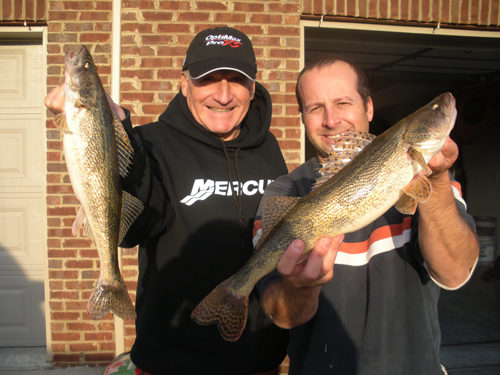BY Lee McClellan
This is the ninth and final installment of a series of articles titled “Fall Fishing Festival” profiling the productive fishing on Kentucky’s lakes, rivers and streams in fall.
FRANKFORT, Ky. – Sauger hover just above bottom right now downstream of dams, waiting for a stunned shad to tumble into their orbit. Their numbers will grow in proportion to the downward slide of the thermometer.

The peak concentration of sauger below dams coincides with the coldest weather of the year. Sauger readily bite in water temperatures below 40 degrees, the most reliable winter fish of all.
With many Kentuckians getting some days off during the holiday season, sauger provide a cast-starved angler a chance to get away from the bustle surrounding the holidays and put some fish in hand.
“I think we are still a little early, the water is still a little warm for this time of year for sauger,” said Ryan Oster, federal aid coordinator for the fisheries division of the Kentucky Department of Fish and Wildlife Resources.
Oster usually starts his sauger fishing on the opening weekend of modern gun deer season as fish begin congregating below dams on the Kentucky and Ohio rivers. They also arrive in large numbers in the tailwater areas below Kentucky Lake, Lake Barkley and Lake Cumberland at roughly the same time.
“December is the start of the really good sauger fishing with the peak coming in February,” he said. “The fishing lasts until late March when they spawn and disperse downstream.”
Oster recently caught sauger up to 18 inches long on a mid-November trip below a lock and dam on the Kentucky River in central Kentucky. “I caught them vertically jigging a blade bait,” he said. “It was an overcast day, so I used a gold blade bait. On clear days, I like silver and blue blade baits. They mimic the shad and shiners sauger eat.”
Sauger also strike 3- to 4-inch pearl, orange and black, chartreuse, orange and lime green curly-tailed grubs rigged on leadheads ranging from ¼ – to ¾-ounce. The weight of the leadhead depends on current. Oster will go up to a 1-ounce weight if needed to get the offering on the bottom. Lures that don’t strike bottom regularly don’t generate many sauger strikes.
“I also fish a 4-inch pearl soft-plastic jerkbait on a ½-ounce leadhead when they are eating larger shad,” Oster said. “The jerkbait seems to draw larger fish, but fewer bites. I also use a pearl 4-inch ringworm in the same situation.”
He prefers blade baits and curly-tailed grubs for numbers of sauger.
Presentation is critical for catching sauger consistently. “You have two options for boat anglers in tailrace areas,” Oster explained. “If you have good flow, fish vertically and jig your lures off the bottom. At normal to low flows, hold your position with a trolling motor and scoot your lure across the bottom.”
Bank anglers below dams should work current seams with grubs rigged on leadheads heavy enough to occasionally strike bottom, but not so heavy they hang up on every cast. Anglers fishing from the bank also catch many sauger fishing live crappie minnows on the bottom in these areas.
The Cumberland River just below Wolf Creek Dam offers excellent bank fishing for winter sauger. The fishing platforms and bank access below Kentucky Lake and Lake Barkley also make highly productive bank fishing spots for these fish.
The public recreation areas immediately downstream of Green River, Barren River and Taylorsville lakes offer excellent bank access. These spots will provide increasingly better sauger fishing in the years to come, due to a stocking effort begun in 2010.
“We saw sauger up to 17 inches in the Green River tailwater and up to 18 inches in the Salt River below Taylorsville Lake in our population sampling this past year,” said David Baker, stream fisheries biologist for Kentucky Fish and Wildlife. “You can catch a combination of walleye and sauger in the Green River. Anglers are beginning to catch sauger up to 15 inches in the Barren River.”
The Green River received 310,000 fingerling sauger while Barren River got 92,000 since 2010. The fisheries division stocked 60,000 sauger in the Salt River below Taylorsville Lake in that time. The stocking effort runs until 2016.
If screaming children, complaining relatives and overeating are giving you the holiday blues, lift your spirits by catching some tasty sauger.
Author Lee McClellan is an award-winning associate editor for Kentucky Afield magazine, the official publication of the Kentucky Department of Fish and Wildlife Resources. He is a life-long hunter and angler, with a passion for smallmouth bass fishing.
-30-
The Kentucky Department of Fish and Wildlife Resources manages, regulates, enforces and promotes responsible use of all fish and wildlife species, their habitats, public wildlife areas and waterways for the benefit of those resources and for public enjoyment. Kentucky Fish and Wildlife is an agency of the Tourism, Arts and Heritage Cabinet. For more information on the department, visit our website at fw.ky.gov.


Be the first to comment